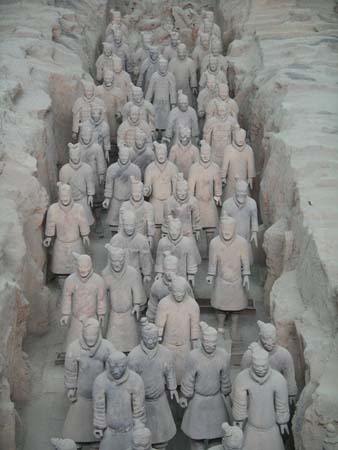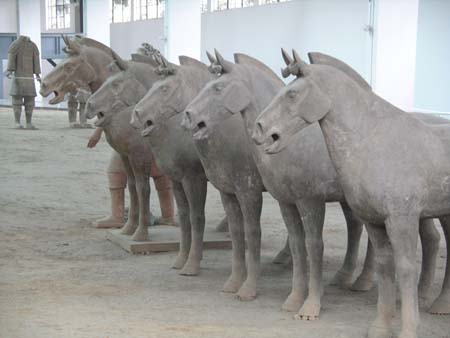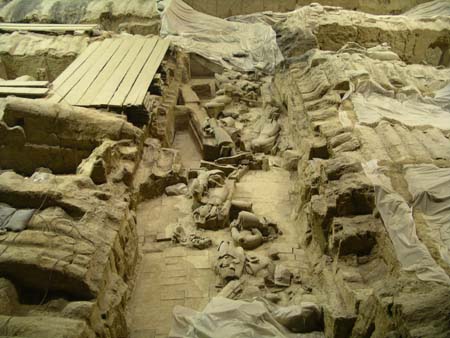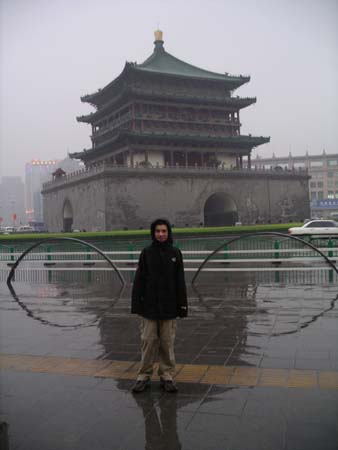Friday, March 19
Paula: We flew to Xi'an early this morning, hoping that our travels south would bring warmer weather. Instead, we found colder temperatures with drizzle. On top of that, the airlines lost my suitcase (it was sent to our hotel this evening) but that didn't dampen our excitement for the main reason for our visit here - the Terracotta Warriors. After we arrived, our guide in Xi'an told us that this site is considered the "eighth wonder of the world" - we weren't so sure about that, but we were looking forward to seeing one of the world's most significant archeological finds of the past 30 years.
 This
site was first discovered in 1974 by a group of farmers digging a well. We
were amused when our guide told us that these three farmers actually sign
autographs each day at the site. When we arrived at the entrance to the Terracotta
Warriors, we again realized that this is simply another example of Chinese
ingenuity when it comes to tourism - there indeed is an older man (who knows
if he was the real farmer) signing autographs at the entrance, but the only
thing he'll sign is a $15.00 souvenir book!
This
site was first discovered in 1974 by a group of farmers digging a well. We
were amused when our guide told us that these three farmers actually sign
autographs each day at the site. When we arrived at the entrance to the Terracotta
Warriors, we again realized that this is simply another example of Chinese
ingenuity when it comes to tourism - there indeed is an older man (who knows
if he was the real farmer) signing autographs at the entrance, but the only
thing he'll sign is a $15.00 souvenir book! 
The site of the Terracotta Warriors consists of three large "pits" of life-sized figures that were unearthed all in the vicinity of Emperor Qin Shihuangdi's mausoleum. He was the first emperor of China and was responsible for uniting the country for the first time. This unity was accomplished by force as was the completion many enormous building projects (a huge mausoleum, many palaces and the Great Wall). Emperor Qin ruled from 221 BC until 206 BC and it was during this time period that Terracotta Warriors were created as protectors for the emperor during his after-life.
 The
area around the site is surrounded by construction vehicles and we had to
laugh as we literally walked around several backhoes that were busy at work.
Our guide explained that there is a major project underway to create a large
garden and tourist pavilion before the Olympics in 2008. Interestingly, we
read in the newspaper just yesterday that the government plans to spend 180
billion dollars in preparing for the Olympic Games! After weaving our way
through the customary souvenirs vendors, watching a fairly interesting film
recreating the history of the Qin Dynastry and having the usual "tourist
lunch" (probably the worst one we've had…) we finally entered the
first of three pits of warriors.
The
area around the site is surrounded by construction vehicles and we had to
laugh as we literally walked around several backhoes that were busy at work.
Our guide explained that there is a major project underway to create a large
garden and tourist pavilion before the Olympics in 2008. Interestingly, we
read in the newspaper just yesterday that the government plans to spend 180
billion dollars in preparing for the Olympic Games! After weaving our way
through the customary souvenirs vendors, watching a fairly interesting film
recreating the history of the Qin Dynastry and having the usual "tourist
lunch" (probably the worst one we've had…) we finally entered the
first of three pits of warriors.
The clay warriors and horses really are quite amazing. These pits contain
over 7,000 warriors, and 1,000 of these have been excavated. The first and
largest pit is the most impressive. After restoration, it is possible to actually
see how the warriors were positioned in battle formation. Chariots pulled
by horses were carefully placed throughout the infantry. Each soldier is different
and it has been suggested that they were made to depict actual soldiers of
the time. When first discovered, the paint on the terracotta was still visible,
but oxygenation destroyed the colors within days of their unearthing. 
The warriors were all heavily damaged when initially discovered and archeologists believe that the damage was actually done in a farmers' rebellion which took place shortly after the emperor died. Many of the warriors have been left exactly as they were found, and it was interesting to see all the broken pieces lying on the ground. The pits were designed with supporting walls and partitions, and were covered by a roof of logs and bamboo. Each of the pits is enclosed now in large hanger-like buildings to protect them. We also viewed two small bronze chariots found in the area and also believed to be part of the emperor's burial site.
As we left the site, we saw one of the vendors outside the parking lot selling North Face Gortex jackets ("made in China", of course). We stopped out of curiosity and need, because David lost his jacket several weeks ago (we think in Melbourne) and was sorely missing it here in the colder temperatures. Steve as always managed to strike a good deal ($25!).
 The
drive into Xi'an was uneventful. It was difficult to get a feel for the countryside
because of the rain but our guide told us that the farmers here grow two crops
a year - winter wheat and corn in the summer. Xi'an is a very large city with
over 6 million people. It was the first ancient capital of China and our guide
described it as "old fashioned" when compared to Beijing or Shanghai.
Our hotel is in the town center and we entered though one of the city's four
gates. A wall was built around Xi'an 600 years ago by the Ming Dynasty and
this wall dramatically still surrounds the city today. The traditional bell
tower and drum tower stand proudly in the center just across from our hotel.
The
drive into Xi'an was uneventful. It was difficult to get a feel for the countryside
because of the rain but our guide told us that the farmers here grow two crops
a year - winter wheat and corn in the summer. Xi'an is a very large city with
over 6 million people. It was the first ancient capital of China and our guide
described it as "old fashioned" when compared to Beijing or Shanghai.
Our hotel is in the town center and we entered though one of the city's four
gates. A wall was built around Xi'an 600 years ago by the Ming Dynasty and
this wall dramatically still surrounds the city today. The traditional bell
tower and drum tower stand proudly in the center just across from our hotel.
We enjoyed a "dumpling banquet" for dinner this evening, and tomorrow we have another morning flight further south to the city of Kunming.
